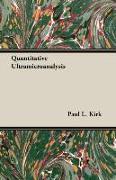- Start
- Quantitative Ultramicroanalysis
Quantitative Ultramicroanalysis
Angebote / Angebote:
QUANTITATIVE ULTRAMICROANALYSIS QUANTITATIVE ULTRAMICROANALYSIS Paul L. Kirk, Ph. D. Professor of Biochemistry University of California John Wiley Sons, Inc., New York Chapjrnan Hall, Limited, London PREFACE Ultramicroanalysis is a field of analytical chemistry in which progress has to some extent paralleled the tremendous advances made in other phases of that subject, such as instrumental analy sis. The remarkable extent of its utilization by the Manhattan Project and the Atomic Energy Commission in both research and production phases of nucleonics has not been appreciated in de tail by the scientific public because of the restrictions of security and the limited release of information. For the same reasons, it must suffice in this volume to state that the contributions made by the use of ultramicrotcchniques were unique and virtually in dispensable to the development of the atomic bomb and the subsequent nuclear investigations. In the long range, the biochemist, clinician, and biological re search investigator stand to profit most from the use of very small-scale methods, and it is to them primarily that this volume is directed. Not only does the field suffer from a scattered and partially inaccessible literature, but the deviations from the accepted standard methods are such as to generate in the minds of some a hesitancy or even a mistrust of methods designed for so great sensitivity. Teaching of ultramicrotechniques for a considerable period of years has demonstrated completely that they are grasped at least as easily as are standard microchcmical methods and that they often yield better results in the hands of students. It is believed that they offer unique value as laboratory training methods and as technical discipline. In many instances they demonstrate the principles of analysis better than could be accomplished by con ventional macro-or even nncromcthods. With them, the research investigator can often by-pass the difficult sampling problems of biological systems by isolating the small and homogeneous system with which sampling errors are best controlled. By so doing he can also obtain information with a wealth of detail which is unique in biochemical analysis. This volume is not intended to include every aspect of the vi PREFACE subject nor to exhaust the bibliographical possibilities. Many methods and techniques have been omitted intentionally, not only because of their deficiency but because they did not fit smoothly into the generalized technical scheme which was followed. Errors of omission have undoubtedly occurred, and, however regrettable, it is inevitable in so scattered a literature that not every method should receive detailed scrutiny. It is also true that many of the highly sensitive methods published fall below the standards of accurate analytical requirements which this author feels must be maintained. I am indebted particularly to the many students and associates whose labors have contributed so greatly to the development and continued interest in this field and without whom this volume could not have been written. Facilities and financing for much of the work reported was generously provided by the Rockefeller Foundation, the American Cancer Society, and the United States Public Health Service, to all of whom a debt of gratitude is due. To many other workers in the field of ultramicrochemistry, partic ularly Dr. K. Linderstr0m-Lang, Dr. H. Holter, Professor E. J. Conway, and Dr. R. Craig, the author is indebted for voluntary cooperation and much unintentional assistance. Appre ciation is due Dr. 0. H. Lowry, Dr. P. F. Scholander, Dr. C. B. Anfinsen, and particularly Dr. C. L. Claff for their willing assist ance in making available much material included in this volume. Acknowledgment is due to authors, publishers, and editors who have willingly granted permission for reproductions, and special thanks are due the Microchemical Specialties Co...
Folgt in ca. 15 Arbeitstagen
